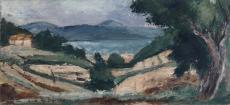


Less than 30 years old at the time, André Dunoyer de Segonzac seized the attention of the Parisian public at the Salon d’Automne and the Salon des Indépendants around 1910-1911 with his monumental, structured, dark-toned canvases, made with a thick impasto, which was applied both with paintbrushes and palette knife, and reminiscent of the art of Gustave Courbet (1819-1877) or the early style of Paul Cézanne (1839-1906). His figures, still lifes and landscapes of the Île-de-France, painted slowly and patiently and marked by a realism which was firmly anchored in French tradition, soon met with success, with Segonzac representing an original form of avant-garde art welcomed by Guillaume Apollinaire and promoted by such adventurous collectors as the famous couturier Paul Poiret (1879-1944). At Poiret’s couture house, Segonzac met Raoul Dufy (18771953) and Maurice de Vlaminck (1876-1958), who were only slightly older than him, and contributed, like them, to events hosted by their sponsor. His personal experience of World War I (he served in the army’s camouflage division) led him to illustrate, in 1919, the novel Les croix de bois by Roland Dorgelès, which remains to this day one of the most poignant testimonials of this conflict.
In the post-war period Segonzac’s importance and celebrity were affirmed, and his fame was established very quickly, in Great Britain and then in America. His method of execution became lighter and his palette paler, but his art remained faithful to his initial orientations. An important element came into play beginning in 1925: Segonzac acquired a property in Saint-Tropez and began to spend longer and longer stretches in this port on France’s Mediterranean coast, which Paul Signac (1863-1935) had discovered 30 years earlier and which Henri Matisse (1869-1954) had also visited. Saint-Tropez, the countryside and the surrounding villages all supplied Segonzac with countless subjects for his oil paintings, as well as his watercolours and his etchings, techniques that took on an increasing importance in his creative process. As in Provence: Paysage à SaintTropez, the composition is often organised around the luminous triangle created by the glimpsed sea as it is delineated by the mountainous profile of the Esterel range silhouetted against the sky. The foreground evokes the rugged surface of the hills of Provence and the modest peasant structures. The layout is underscored here by the adoption of a very elongated format outside standard measures (often favoured by the artist), which unfurls the painter’s panoramic vision. According to the artist’s own words written on the back of a photograph, this painting, which he called simply Provence, was most likely produced in 1927. Segonzac rarely dated his works after 1920 and even boasted a certain reluctance in this regard, wishing instead to emphasise the importance of continuity in his art. In fact, one of his masterpieces, the illustration of Virgil’s Georgics, a project supported by the famous art dealer and publisher Ambroise Vollard (1886-1939) as early as 1927 but not completed until 1947, reprises the same motifs addressed in Saint-Tropez. Similar Mediterranean landscapes also illustrate the work of his neighbour and friend, the writer Colette, entitled La treille muscate (1932), after the name of her house in Saint-Tropez.
He was a painter, in oils and watercolours, etcher and book illustrator, renowned in France, Britain and America. He was one of the modernists chosen to exhibit in the Armory Show in New York in 1913. His monumental, dark-toned canvases of nudes, still lifes and landscapes, made with a thick impasto, are marked by a realism firmly rooted in the French tradition. His style and palette lightened, particularly after 1925, and his elegant watercolours and prints were created with a great spontaneity.